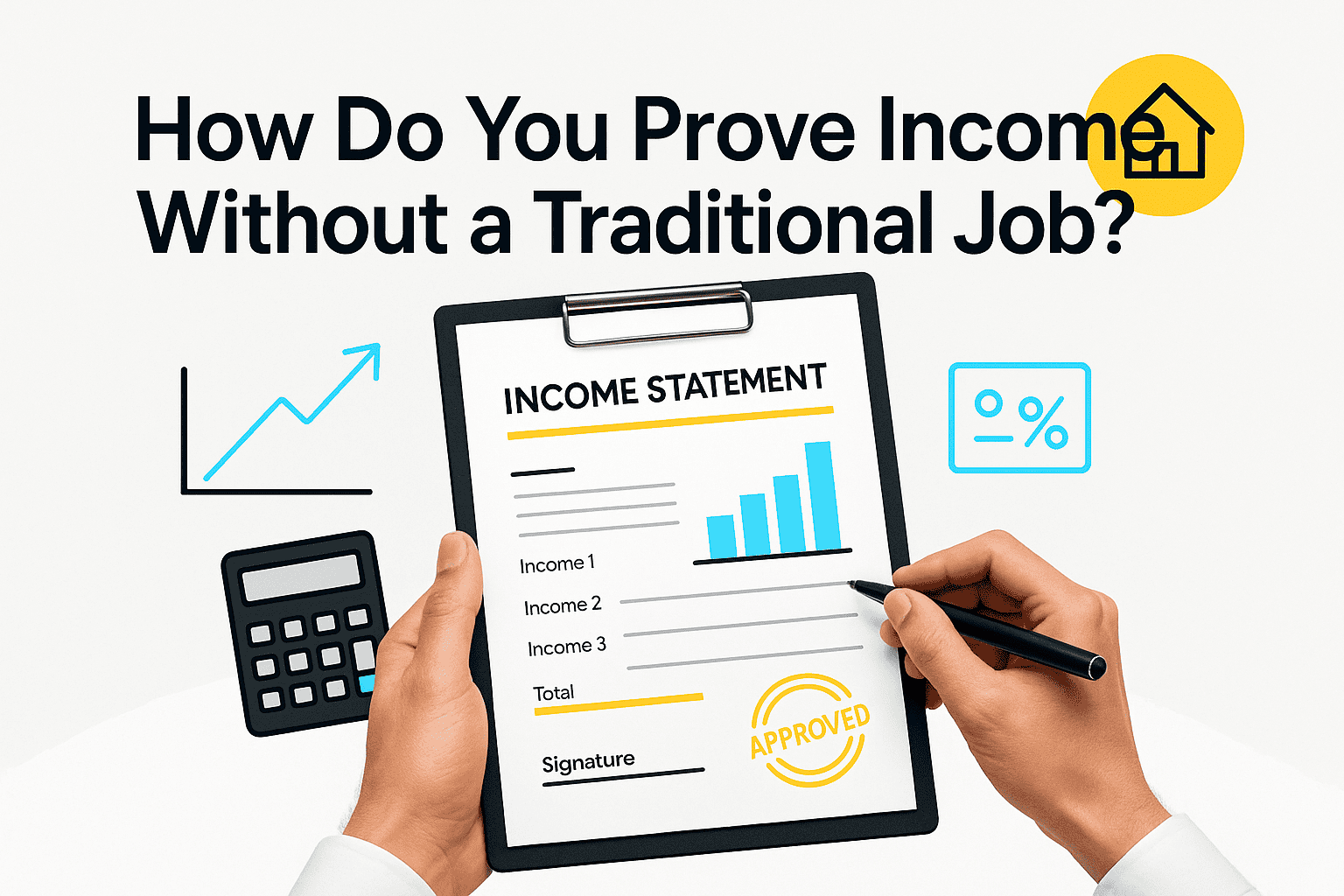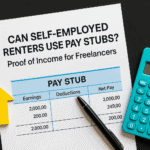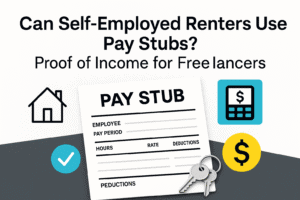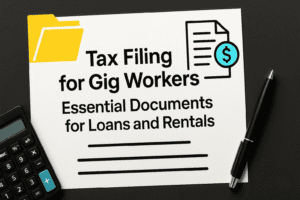Last updated: August 2025
Whether you’re a freelancer, contractor, gig worker or running several side hustles, proving your income is essential for applications. Reviewers want reliable, verifiable data, even when pay cycles are irregular. This guide shows how to prove income without a traditional job using official records and compliant formatting—not fabrication.
At FinancialDocsProvider.com, our compliance‑first team organizes, standardizes and packages your legitimate financial records for fast review. We never change facts or invent numbers. We focus on clarity, consistency and audit‑readiness so landlords, lenders and agencies can verify your documents without friction.
Below you’ll find legal guardrails across the US, UK and Canada, plus practical steps and mini‑scenarios tailored to independent earners. We also include checklists and official links so you can submit a professional packet with confidence and minimize back‑and‑forth.
Related Entities & Terms
- IRS, CFPB and FTC (US regulators); FCA and HMRC (UK regulators); CRA and FCAC (Canadian regulators)
- W‑2 (employees), 1099‑NEC/1099‑K (US contractors), Schedule C and Schedule SE, SA302 (UK), P60/P45, Notice of Assessment (Canada), Proof of Income Statement (Option C)
- Bank statements, payout summaries, invoices, merchant processor reports
- Income verification letters, rental applications, underwriting and credit decisions
- OCR, redaction, PDF/A export, accessibility formatting and version control
- Fraud detection, document reconciliation, audit trails and variance notes
- Gig platforms: Uber, Lyft, DoorDash, Upwork, Fiverr and Shopify
- Record‑keeping rules, tax transcripts, SA302 forms, CRA My Account and HMRC Self Assessment
What are the legal basics of proving income without a traditional job?
Regulators in the US, UK and Canada prioritize accuracy, provenance and privacy. You can enhance presentation and redact sensitive data, but you cannot alter facts. Using government‑issued summaries and bank‑generated statements is the fastest way to pass verification.
In the United States, the Internal Revenue Service requires self‑employed individuals to report income on Schedule C and compute self‑employment tax on Schedule SE. These returns anchor your income narrative for lenders and landlords. For third‑party verification, obtain an IRS tax transcript online or by mail; mailed copies typically arrive within 5–10 days and mask personal identifiers while showing the financial data reviewers need.
In the UK, HMRC’s SA302 tax calculation provides a concise summary of income, allowances and tax due—ideal for underwriters. HMRC also expects self‑employed people to keep records of sales, income, expenses, receipts and bank statements that corroborate filings. In Canada, the CRA’s Proof of Income Statement (Option C) offers an official snapshot of reported income and deductions. You can access it via your CRA My Account or order by mail, usually in about 10 days.
Allowed edits
- Redacting account numbers or sensitive IDs
- Fixing page order, orientation and readability
- Exporting to searchable PDF (OCR) and adding cover pages
- Summarizing variable income in a clearly sourced table
- Including cross‑references (e.g., “See Bank, Feb 2025, p.3”) to speed spot checks.
- Standardizing date and currency formats without changing values.
Illegal alterations
- Changing amounts, balances or transaction details
- Backdating payments or editing pay dates
- Swapping payer or payee names or editing account owners
- Fabricating documents, logos or income that was not earned
- Doctoring PDFs to hide overdrafts, late fees or chargebacks.
- Injecting “placeholder” transactions or rounding balances up.
If a bank or platform makes an error, request a corrected document from the issuer. Self‑editing statements can trigger fraud flags and penalties, as our internal guide cautions. A transparent paper trail, paired with professional formatting, gives reviewers confidence from page one.

Which edits are allowed when preparing income proof?
Clean presentation isn’t just permissible—it’s expected. Underwriters and leasing teams often reject packets that are messy, inconsistent or hard to read. You must not alter underlying facts, but you can structure, label and summarize your data so reviewers can verify it quickly.
Below are common, compliance‑approved edits we apply every day. These upgrades reduce friction without changing a single number.
Readability & structure
- Merge and order pages chronologically: Combine statements, payouts and invoices so the timeline reads forward. Begin with the oldest month and move to the most recent.
- Standardize date formats: Align formats across documents (e.g., YYYY‑MM‑DD) to eliminate confusion.
- Apply OCR and bookmarks: Create a searchable PDF and add bookmarks (or a contents page) for fast navigation.
- Consistent file naming: Use descriptive, dated names such as “2025‑02 Bank of North – Checking – pp.1‑6”.
- Number every page: Add footers like “Packet p. 1 of 42” to support audit trails.
- Cross‑document mapping: Reference where deposits appear on both platform payouts and bank statements.
Privacy‑safe redactions
- Mask sensitive identifiers: Redact all but the last four digits of account and government ID numbers.
- Client confidentiality: Where contracts allow, abbreviate client names on invoices while preserving dates and amounts.
- Address minimization: Remove home addresses not required for verification, especially on statements.
- Use true redaction tools: Avoid “overlay boxes.” Apply vector redaction that deletes underlying text.
Export & packaging
- Export platform dashboards: Download official PDFs from Uber, Lyft, DoorDash, Upwork, Fiverr or Shopify—not screenshots.
- Include CSV summaries: Convert CSVs into a concise table and attach the raw file as an appendix.
- Add variance notes: Explain seasonality or one‑off projects in a short note that points to the source evidence.
- Accessibility & compliance: Export to PDF/A when possible and include selectable text for screening tools.
- Cover page: Use a one‑page executive summary with income sources, date ranges and document index.
These edits help busy reviewers verify deposits, tie payouts to invoices and understand fluctuations. The result is a streamlined packet that reduces follow‑up questions and accelerates decisions.
What edits are illegal when documenting your income?
Altering facts is fraud. Across the US, UK and Canada, changing totals, dates or payee names is illegal and risks severe penalties. Reviewers use automated checks, metadata analysis and cross‑system matching to detect tampering.
The following actions are off‑limits:
- Editing dollar amounts, balances or tax lines: Even “minor” rounding can qualify as misrepresentation.
- Creating false transactions or pay periods: Backdating income, inventing clients or adding deposits that never occurred is fraudulent.
- Using someone else’s documents: Submitting another person’s pay stub, invoice or transcript can constitute identity fraud.
- Falsifying logos or letterhead: Copying a bank or employer logo onto a template is forgery.
- Manipulating check images or mobile deposit artifacts: Image edits are traceable and often flagged.
- Metadata tampering: Re‑saving PDFs to hide edit history can raise red flags during screening.
If a document contains an error, ask the issuer for an official correction rather than editing values yourself. Provide supporting context from your bank, platform or accountant to keep the record straight.
When do you need professional document formatting?
Some applications accept a simple set of statements. Others demand a polished, indexed packet that speaks the lender’s language. When income is variable, project‑based or multi‑platform, professional packaging can be the difference between approval and delay.
Below are common scenarios and the artifacts reviewers expect. Each packet blends official summaries with recent activity to present a complete, credible picture.
Renters & property managers
Landlords typically want recent, regular income covering 2½–3× monthly rent. Build a concise, verifiable packet:
- Three to six months of bank statements with consistent deposits.
- Platform payout summaries or invoices with paid receipts.
- An IRS transcript, HMRC SA302 or CRA Notice of Assessment for prior‑year confirmation.
- An income verification letter summarizing sources, seasonality and average monthly earnings.
- Example: A rideshare + design freelancer includes Uber weekly PDFs, Upwork monthly statements and a one‑page table of monthly totals.
For a deeper dive into rental requirements, see our post on same‑day proof of income options.
Auto loans & dealer financing
Dealers assess ability to pay and stability. Provide artifacts that tie deposits to work performed:
- At least three months of bank statements showing deposit history and averages.
- Merchant processor reports (Stripe, PayPal, Square) or platform payouts.
- A recent tax document—US: IRS transcript; UK: SA302; Canada: Proof of Income Statement.
- Example: A Shopify seller includes Stripe monthly summaries, matching bank deposits and a brief variance note explaining holiday spikes.
Small‑business loans & lines of credit
SBA and SME underwriters want a 360‑degree view: performance, pipeline and cash flow. Present current‑year activity with prior‑year proof.
- A 12‑month profit & loss summary with footnotes for any large swings.
- Business bank statements for 3–6 months plus merchant processor reports.
- Prior‑year tax return (or transcript) and year‑to‑date summary.
- Client roster or contract excerpts, if permitted, to show continuity.
- Example: A consultant attaches a pipeline schedule, mapping retainer contracts to monthly deposits.
Mortgage pre‑approval
Mortgage lenders need longer look‑backs and clear explanations. Expect to provide more years and more context.
- Two years of filed returns or official transcripts.
- Personal and business bank statements for the requested review period.
- Letters of explanation for one‑off deposits or income dips.
- Example: A photographer provides two years of returns plus a seasonality note covering wedding season peaks.
Benefits, visas & grants
Government programs rely on clear, official proof. Follow their forms exactly and avoid omissions.
- An official income statement (IRS transcript, HMRC SA302, CRA Proof of Income Statement).
- Recent statements and invoices that verify current earnings.
- Agency‑specific forms downloaded from their site, completed as instructed.
- Example: A grant applicant attaches a CRA Proof of Income Statement plus three months of invoices and paid receipts.
Platform‑based work (rideshare, freelance marketplaces)
Download official monthly or weekly earnings statements from each platform account. Avoid screenshots—export PDFs or CSVs and include a summary table. If a pay‑stub style summary is needed, our freelancer pay stub guide explains when and how to generate a compliant summary.
If you also hold a part‑time W‑2 job, include recent W‑2 stubs and label each income source clearly. That clarity helps underwriters evaluate stability without guesswork.
How does our service work?
FinancialDocsProvider.com specializes in organizing and formatting the documents you already have. We never fabricate records. Our process is transparent, secure and designed to align with lender, landlord and agency checklists.
1) Intake
- Tell us the purpose (rental, auto, SBA, mortgage, visa, grant) and share any reviewer checklists.
- Provide originals: bank statements, platform exports, invoices, tax documents and any instructions from the requester.
- We perform a quick scoping call or questionnaire to confirm dates, entities and required formats.
2) Reconciliation
- We reconcile income sources to the requested date ranges, highlighting gaps or mismatches.
- If documents are missing or contain errors, we recommend legal remedies, such as requesting a corrected bank statement, an IRS transcript, an HMRC SA302 or a CRA Proof of Income Statement.
- We flag items that need explanations, like large one‑off deposits or seasonal spikes.
3) Formatting & packaging
- We merge, normalize dates, add bookmarks, apply OCR and redact sensitive identifiers.
- We build a cover page listing each document, its date range and a high‑level income summary.
- When helpful, we include a one‑page table summarizing monthly earnings sourced to the underlying statements.
- We export to audit‑friendly PDF/A and verify legibility at common compression levels.
4) Delivery
- We deliver a neatly packaged PDF and, if requested, a zipped folder of the originals. Turnaround is usually 24–48 hours, with same‑day service for urgent cases.
- You receive an index and cross‑references so underwriters can spot‑check fast. We remain available for minor tweaks if a reviewer requests more detail.
Our commitment is confidentiality and compliance. We do not share your data without consent, and we do not modify factual content—ever.
What belongs in your no‑traditional‑job proof‑of‑income packet?
Use this checklist to assemble a clean, credible packet. Tailor it to the reviewer’s instructions and your mix of income streams.
Before you start
- Confirm requirements: Which documents, what date range and whether originals or copies are needed.
- Gather evidence: bank statements, invoices, platform payouts, P&L statements and tax documents (transcripts, SA302, NOA).
- Ensure names and addresses match across documents; if not, include a brief note explaining differences.
- Redact safely: remove only account numbers and personal identifiers; keep dates, amounts and descriptions visible.
- Stabilize file logistics: consistent naming, page numbering and a single master PDF with bookmarks.
Build a clean packet
- Create a cover page listing each document, its source and date range.
- Place statements and payouts in chronological order and number every page.
- Add a one‑page summary table with monthly totals, referencing the source pages.
- Bookmark sections (e.g., “Bank – Jan–Mar 2025”, “Upwork Payouts – Q1 2025”).
- Export to a searchable, legible PDF. Confirm file size and readability after compression.
Mini‑scenarios
Adapt these examples to your situation:
- Wedding photographer: Provide invoices, paid receipts, a seasonality note and a monthly revenue table.
- Rideshare driver: Include weekly platform statements, a monthly summary and bank deposits that match payouts.
- Web developer: Separate retainer income from project income so underwriters see predictable cash flow.
- Content creator: Combine AdSense/creator‑platform statements with affiliate reports and matching deposits.
Which red flags cause income proof rejections?
Screening teams look for internal consistency and credible provenance. Small errors can stall an application, while obvious tampering can trigger denial and investigation. Avoid these common hazards:
- Inconsistent names: A nickname on invoices but a legal name on bank statements creates confusion. Align or explain.
- Gaps in statements: Missing months or unexplained breaks in deposit history raise suspicion. Provide all periods and note any gaps.
- Unrealistic spikes: Large deposits without documentation or explanation invite additional scrutiny.
- Editable PDF metadata: Some lenders check metadata for signs of editing. Prefer original downloads over image‑to‑PDF tools.
- Low‑quality scans: Blurry, cropped or skewed pages slow verification. Use high‑resolution scans or issuer PDFs.
- Misaligned numbers: Totals that don’t match between platform reports and bank deposits are a common rejection driver.
- Visual tells of tampering: Mismatched fonts, kerning anomalies, uneven spacing or repeated check numbers stand out.
A professional prep service helps neutralize these risks by enforcing consistency and providing explanations where needed.
Where can you find official resources for verifying income?
Rely on authoritative sources to anchor your packet. These agencies publish the official forms, transcripts and guidance reviewers trust. Pair them with recent bank evidence to complete the picture.
- IRS Get Transcript service: Request tax return or account transcripts online or by mail; mailed transcripts arrive within 5–10 days and mask personal identifiers.
- IRS Self‑Employed Tax Center: Learn how to file Schedule C and Schedule SE to report gig or business income.
- HMRC record‑keeping guidance: Review the records you must keep if you’re self‑employed, including sales, expenses and receipts.
- HMRC SA302 tax calculation: See what’s included in your SA302 and how to download it.
- CRA Proof of Income Statement (Option C): Access your income summary via CRA My Account or order a copy by mail.
- U.S. Treasury income verification guidance: The Homeowner Assistance Fund accepts pay stubs, W‑2s, IRS Form 1099s, tax filings, bank statements and employer attestations as proof of income.
- Proof of income for freelancers and gig workers – our comprehensive internal guide covers legal basics, document types and packaging techniques.
- Same‑day proof of income options – learn how to assemble packets quickly for urgent applications.
- Pay stubs vs. bank statements – compare the strengths of each document type for income verification.
- Fixing bank statement errors legally – step‑by‑step guidance on disputing inaccuracies.
For additional support, explore our proof of income editing services, bank statement formatting and pricing pages, or contact our team directly.
FAQs
- How can I prove my income if most of it comes from cash or tips?
- Track every cash payment with invoices or receipts and deposit cash regularly so the bank trail is clear. Pair bank statements with an invoice ledger that matches deposits to work performed. A simple monthly summary table helps reviewers verify totals at a glance.
- Are 1099 forms acceptable proof of income?
- Yes. In the US, Forms 1099‑NEC and 1099‑K document non‑employee income or platform payments. Lenders often request 1099s alongside bank statements and a Schedule C return; the U.S. Treasury lists 1099s among accepted proof documents.
- What if I receive irregular payouts from different gig platforms?
- Download official statements from each platform and organize by month. Summarize totals by platform in a table and include brief variance notes for seasonal spikes or gaps.
- Do I need a tax transcript if I haven’t filed yet?
- If you haven’t filed, you won’t have a transcript. Provide bank statements, invoices, platform payouts and a provisional profit & loss. After filing, request a transcript from the IRS or CRA to strengthen the packet.
- When should I hire a professional to prepare my income documents?
- Bring in help when timing is tight, income streams are complex or the review standard is strict (e.g., mortgages). We handle formatting, reconciliation and indexing so reviewers can verify quickly and you can focus on your business.
Need accurate, reliable financial documents fast? Contact FinancialDocsProvider.com now.








Add comment